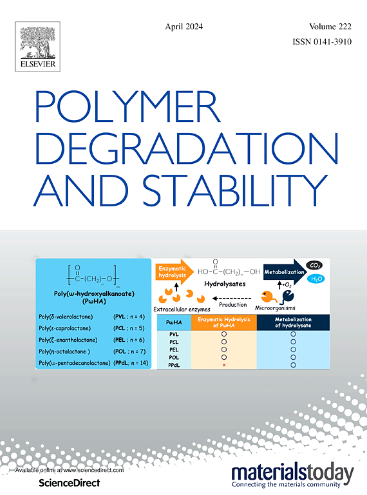PAEK 和 CF/PAEK 复合材料在长期高温条件下的热力学和老化行为表征
IF 6.3
2区 化学
Q1 POLYMER SCIENCE
引用次数: 0
摘要
使用碳纤维(CF)增强的聚(芳基醚酮)(PAEK)聚合物的使用日益增多,其目的是满足热塑性复合材料应用中对机械性能和高温下热稳定性的日益增长的需求。本研究调查了 PAEK 和 CF/PAEK 复合材料在 15 天、30 天和 45 天的长期高温暴露(150 °C、200 °C 和 250 °C)条件下的物理化学特性,旨在阐明其耐久性机理并加深对其性能的理解。具体而言,评估了材料在长期高温处理后的弯曲性能和动态热机械性能的变化。结果表明,PAEK 和 CF/PAEK 复合材料都具有长期高温应用的巨大潜力,其中 CF 不会显著改变 PAEK 基体的基本高温响应。关于耐久性机制,在 150 ℃ 时,PAEK 的无定形区会发生链的重新定向,而在 200 ℃ 和 250 ℃ 时则会引起明显的二次结晶,从而显著改善这些材料的高温机械性能。此外,在高达 250 ℃ 的温度下,PAEK 的无定形分子链会因氧化裂解而形成较短的线性链片段。这项研究不仅丰富了 PAEK 和 CF/PAEK 复合材料经长期高温处理后性能的现有数据,还进一步揭示了其耐久性机理。本文章由计算机程序翻译,如有差异,请以英文原文为准。
Characterization of the thermomechanical and aging behaviour of PAEK and CF/PAEK composites under long-term high-temperatures
The growing use of poly(aryl ether ketone) (PAEK) polymers reinforced with carbon fiber (CF) aims to meet the increasing demand for thermoplastic composites in applications that require excellent mechanical properties and thermal stability at higher temperatures. This study investigated the physicochemical properties of PAEK and CF/PAEK composites under long-term high-temperature exposure (150 °C, 200 °C and 250 °C) for durations of 15, 30, and 45 days, aiming to elucidate the durability mechanisms and enhance understanding of their performance. Specifically, the changes in the flexural properties and dynamic thermo-mechanical properties of the materials were evaluated after long-term high-temperature treatment. The results indicated that both PAEK and CF/PAEK composites possess substantial potential for long-term high-temperature applications, with CF not significantly altering the fundamental high-temperature response of the PAEK matrix. Regarding durability mechanisms, at 150 °C, PAEK's amorphous region undergoes chain reorientation, while temperatures of 200 °C and 250 °C induce significant secondary crystallization, which significantly improved the high-temperature mechanical properties of these materials. Additionally, at temperatures up to 250 °C, shorter linear chain fragments form through oxidative scission in PAEK's amorphous molecular chains. This work not only enriches the existing data on the properties of PAEK and CF/PAEK composites after long-term high-temperature treatment, but also provides further insights into their durability mechanisms.
求助全文
通过发布文献求助,成功后即可免费获取论文全文。
去求助
来源期刊

Polymer Degradation and Stability
化学-高分子科学
CiteScore
10.10
自引率
10.20%
发文量
325
审稿时长
23 days
期刊介绍:
Polymer Degradation and Stability deals with the degradation reactions and their control which are a major preoccupation of practitioners of the many and diverse aspects of modern polymer technology.
Deteriorative reactions occur during processing, when polymers are subjected to heat, oxygen and mechanical stress, and during the useful life of the materials when oxygen and sunlight are the most important degradative agencies. In more specialised applications, degradation may be induced by high energy radiation, ozone, atmospheric pollutants, mechanical stress, biological action, hydrolysis and many other influences. The mechanisms of these reactions and stabilisation processes must be understood if the technology and application of polymers are to continue to advance. The reporting of investigations of this kind is therefore a major function of this journal.
However there are also new developments in polymer technology in which degradation processes find positive applications. For example, photodegradable plastics are now available, the recycling of polymeric products will become increasingly important, degradation and combustion studies are involved in the definition of the fire hazards which are associated with polymeric materials and the microelectronics industry is vitally dependent upon polymer degradation in the manufacture of its circuitry. Polymer properties may also be improved by processes like curing and grafting, the chemistry of which can be closely related to that which causes physical deterioration in other circumstances.
 求助内容:
求助内容: 应助结果提醒方式:
应助结果提醒方式:


